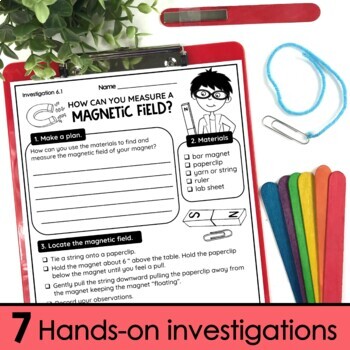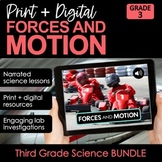Forces and Motion, Electricity and Magnetism Third Grade Science Unit NGSS
- Zip
What educators are saying
Also included in
- This third grade science bundle includes both print and digital versions of Forces & Motion | NGSS. It includes EVERYTHING you need to teach, practice, experiment, and assess 27 days of NGSS aligned lessons on forces, motion, electricity, magnets, and magnetism.Students learn: · Patterns of MotiPrice $28.00Original Price $36.00Save $8.00
- Teaching third grade science, aligned the Next Generation Science Standards, is quite challenging without quality resources to guide you. These in-depth science units address all the 3rd grade NGSS topics and enable you to plan and teach highly-engaging lessons that don’t take hours to plan becausePrice $106.00Original Price $132.00Save $26.00
Description
This third grade force and motion resource is a combination of two NGSS topics into one in-depth unit for teaching forces, motion, electricity, and magnets/magnetism aligned to NGSS as well as many 3rd grade state science standards. This is a high-value science resource in which you are getting two complete units for the price of one.
This unit is also available in a bundle with its digital companion and narrated, audio lessons CLICK HERE.
Students are engaged through 23 high-interest lessons in a vividly detailed teaching PowerPoint. During each lesson, students are presented with engineering connections and real-world problems that enable them to understand how forces, motion, electricity, and magnetism are used in their everyday lives.
Students gain lab experience and use science process skills as they plan and carry out investigations and experiments. Lessons are followed up by science journal activities that reinforce the lesson, turn and talk partner discussion questions, and partner activity labs.
Assessing each lesson is easily differentiated using the fill-in-the-blank option or the short, written response format. A unit test concludes the unit.
This resource includes detailed, scripted lesson plans, focus wall guiding questions posters and objectives cards, science center extension activities, and related lesson videos and books list all in a helpful planning binder. I’ve made it easier than ever to plan and teach a highly engaging and effective science unit, stress-free!
UNIT COMPONENTS
- A complete Teacher’s Guide with a 31-day Pacing Guide
- Standards alignment pages with NGSS, TEKS, and CCSS for each lesson
- Detailed, scripted lesson plans. Each lesson takes 4-7 days to teach.
- 7 Hands-on, investigations with lab procedures and step-by-step directions with photos.
- 8 Partner activity labs
- 6 Chapter Teaching PowerPoint to guide you through 23 engaging lessons with Turn and Talk partner discussion and Independent Activity slides after each lesson.
- Science Focus Wall with essential questions and learning target posters
- Student science journal booklet with activity pages to support each lesson
- Vocabulary cards + full-page posters
- Quick Check/Exit Tickets in 2 formats for each lesson (short written response or fill in the blank) with answer keys
- Final Assessment & Answer Keys
- Related videos and book list
4 Literacy & Math-Based Science Centers
These games and task cards are ideal to add to your literacy centers to reinforce science content as students practice these skills:
Vocabulary
Cause & Effect
Visual Literacy
Mathematical Practice
LESSON TOPICS
Lesson 1.1 Position and Motion
Lesson 1.2 Measuring Motion
Lesson 1 Lab: How does shape affect motion?
Lesson 2.1 Patterns of Motion
Lesson 2.2 Patterns Can Change
Lesson 2 Lab: Predicting Patterns
Lesson 3.1 Forces and Motion
Lesson 3.2 Contact & Noncontact Forces
Lesson 3 Lab: Chain reactions
Lesson 4.1 Balanced and Unbalanced Forces
Lesson 4.2 Combined Forces
Lesson 4.3 Measuring Force
Lesson 4.4 The Floating Train
Lesson 4 Lab: How can forces hold up objects?
Lesson 5.1 Exploring Electricity
Lesson 5.2 Static Electricity
Lesson 5.3 Determining the Strength of a Force
Lesson 5 Lab: How can electric force levitate objects
Lesson 6.1 Magnets and Magnetism
Lesson 6.2 Magnetic Fields
Lesson 6.3 Electromagnets
Lesson 6 Lab 1: How can you measure the size of a magnetic field?
Lesson 6 Lab 2: How can magnets sort objects by weight?
Please see the preview for details and pictures of everything included in this unit.
Click here to download a Lab Materials List.
Happy teaching!
Linda Kamp
Around the Kampfire
Additional third grade science units in this series:
Scientists & The Scientific Method
Environment, Survival & Fossil Evidence
Third Grade Science Yearlong BUNDLE
Click HERE for DIGITAL science units
Click HERE for 2nd grade science units.







